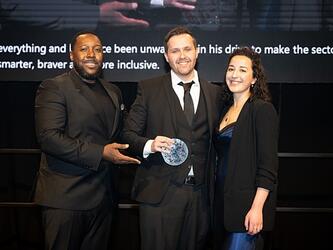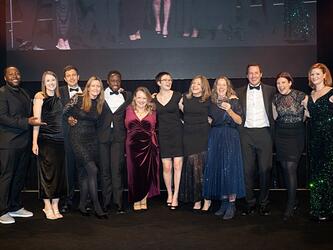Networked individual
Monday
My week starts with a gruelling one-and-a-half hour drive to the Ericsson office in Gurgaon, a satellite city 45km from Delhi, where I live. Gurgaon is the industrial and business hub for all the big multinational corporations in India and Delhi is one of the most painful cities in the world for commuting, so I spend a lot of my time waiting in traffic jams, which gives me the chance to try out new apps on my smartphone.
Ericsson is primarily an infrastructure provider, enabling ICT for our customers and building networks for them. Almost 40% of all global communications traffic travels through our networks. I work at Ericsson’s ConsumerLab, the consumer insights division, which sits within the strategy and marketing organisation. It’s a very important asset for the company, which is a hard-core engineering organisation.
We are more of a b2b company than a direct-to-consumer firm, so the ConsumerLab’s fundamental objective is to bring the voice of the consumer into the organisation – to advise our customers on consumer expectations, our product portfolio, sales and R&D.
If you are a consumer insight professional, it is important to live the life of the consumer. So for me, the time I spend testing apps while stuck in traffic is an opportunity to keep pace and get ahead of what’s happening in the market today.
Once in the office, we have a status update meeting with all our suppliers and agencies. We’re currently running a big project looking at consumer experience – trying to understand the journey the customer takes from the moment he buys his mobile connection; so we always set aside 90 minutes on a Monday to get an idea of what’s happening in the field, how things are progressing, and looking at project timelines to make sure everything is running smoothly.
After the call, the real business starts. I get a lot of requests internally from different teams – from strategy, from marketing, from the account teams who are handling our key customers – and it’s important to respond to these different functions in a timely manner. And the timings here are ruthless. Usually, these requests are, “We need this in the next hour”. So we need to be efficient – and we are – but it’s important to manage expectations and ensure that we are not compromising on the quality, the integrity and credibility of our function.
Crosstown traffic: Jasmeet keeps busy while stuck in Delhi’s notorious traffic jams
Tuesday
Today is all about internal alignment. There are seven different engagement practices within the business, all dealing with different product lines – from TV to mobile broadband. It’s important for us to align ourselves with what it is that those practices need so we can help them to open the door to the c-suite, the top executives, in their clients’ organisations.
So, Tuesday starts with a lot of meetings – most likely with the network planning teams or the mobile broadband practice areas. These engineering teams I think really appreciate that we’re trying to bring a business and consumer angle to
proceedings. But it’s been a tough sell getting to this point. I remember that when I joined ConsumerLab, people expected me to be wearing a white coat and doing sophisticated R&D experiments, because that’s what they thought a lab was all about. So we’ve had to change that perspective, to say: “Hey, we’re not here to do experiments, we’re here to bring the voice of the consumer to you.” That’s something that people now appreciate and find useful.
For example, when we meet the network planning teams they tend to talk a lot about network performance indicators, and it’s important for them to understand the impact that usage of different services and applications is having, or might have, on the network. So, our job is to tell them how these new technologies will change consumer behaviour so they know how to design, or optimise, the network to ensure that the end-user gets the best-possible experience.
After these alignment meetings – usually on Tuesdays – we have a time slot to allow entrepreneurs – small agencies with niche offerings and services, as well as app developers – to come in with their wacky ideas and explain how they might be able to help us with our market research. These innovations keep our insights fresh and give us a new perspective – and the management at Ericsson is encouraging of innovation in the way we try to understand consumers.
At the end of the day, I’ll pay a visit to our experience centre – a test environment where we have demo versions of devices and technologies. I don’t miss an opportunity to visit and speak to the staff there about the latest devices, the new features and functionality.
Staying connected: Jasmeet test-drives the latest kit in Ericsson’s experience centre
Wednesday
At any one time, the consumer insights team has lots of projects running and I usually spend one day a week in a different part of the country, out in the field. I don’t want to just be sitting in an air- conditioned office space forecasting what the next consumer trend will be. I feel you really need to be close to the end-consumer, so attending these interviews – or at times doing them myself – really helps keep me clued into the mind of the user.
Consumer insight functions hinge on storytelling, and a lot of the best stories that we tell are gained from first-hand experience in the field – from the consumers themselves. My most recent trip was down south to attend a qualitative, in-depth interview. I took a three- hour flight from Delhi to Chennai, met our agency partners and contacts and travelled to a location in the city to visit a consumer at their home. It’s a long day – as I’ll usually travel back the same day – but it’s a rewarding and exciting experience.
Thursday
I’m exhausted after all that travelling, so it’s a late start on Thursday, but there is no let-up. A very important part of the ConsumerLab function is to support and advise our customers on consumer behaviour. Usually towards the end of the week, we have a presentation to make to the c-suite of a customer company.
We’re typically used as the door-opener to the chief marketing officer, the chief technology officer or the chief executive of the operator organisation. We start preparing the presentation on Monday and then, by the end of the week, we have to deliver it to key decision-makers in the operator company. They want to listen to what’s happening in the consumer domain and what important decisions they need to make to stay ahead of the market.
Group think: Jasmeet sits in on a group discussion in a temple in rural India
Friday
Today is a catch-up day. I have a weekly meeting with my boss, who is the vice-president of marketing and strategy, and we chat about what has transpired from the week and what we have learned. We also chalk out areas that we might need to address in the coming weeks and any new insights he might need to support his discussions with the regional leadership team.
Also we’ll discuss innovation and methodology, because we do need senior-level support to get budgetary approval for different projects and studies. Five years back, if I had gone to a stakeholder to ask for budget, I would have been shot down. But things have changed. Our CEO, Hans Vestberg, always opens his presentations by talking about what consumers want; so everybody in the business understands the importance of what we do.
But we do need to substantiate every dollar being spent. It’s about give and take. You have to make people understand the objectives and what they are going to get in return.
This article was first published in Impact, the new quarterly magazine from the Market Research Society. Follow the link to read the digital version of Impact.
Includes:
- A special report on customer experience
- Profiles of the Tate, SABMiller and Auto Trader, showing how they use data and insight to shape strategy and decision-making
- How the UK government’s Nudge Unit is changing policy development
- How hackathons can help data and analytics companies innovate

We hope you enjoyed this article.
Research Live is published by MRS.
The Market Research Society (MRS) exists to promote and protect the research sector, showcasing how research delivers impact for businesses and government.
Members of MRS enjoy many benefits including tailoured policy guidance, discounts on training and conferences, and access to member-only content.
For example, there's an archive of winning case studies from over a decade of MRS Awards.
Find out more about the benefits of joining MRS here.













0 Comments